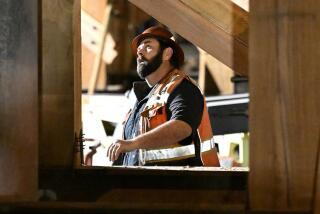Businesses add jobs, but unemployment rate unchanged in September
Employers nationwide boosted hiring last month, but the pace was sluggish as the economy was stuck in low gear — neither speeding up nor downshifting, as feared, into a double-dip recession.
About 103,000 net new jobs were created, more than experts predicted. But that didn’t affect September’s unemployment rate, which remained unchanged at 9.1% for the third straight month, according to the U.S. Labor Department.
The department also reported Friday that job growth for July and August was higher than it previously had estimated.
Share your story about the economic downturn
Still, even with those small bright spots, the forecast is far from sunny. On average, the economy has produced fewer than 100,000 jobs a month since spring.
That’s below the estimated 125,000 needed to keep pace with a growing population, let alone reduce the ranks of the 14 million Americans who are unemployed.
Beneath the surface, the report held more evidence that the labor market has severe problems, even as President Obama and Republican lawmakers spar over tax and spending policies.
Manufacturing, which had led the recovery early on, lost steam as factory employment dropped for the second straight month.
The percentage of long-term unemployed, whose skills and prospects tend to atrophy as time passes, climbed to near-record highs. And the number of part-time workers who want full-time employment rose sharply to 9.3 million from 8.8 million in August.
When these so-called involuntary part-time workers are counted, along with people who have stopped looking for work because they have become too discouraged, the unemployment rate was 16.5% last month, up from 16.2% in August and 15.8% in May.
The broader measure “is very discouraging,” said Harry Holzer, a labor economist at the Urban Institute and Georgetown University. It “reminds us that the labor market hasn’t recovered as much as we thought.”
He said employers may choose to increase the hours of part-time workers in coming months rather than expanding their workforce.
Best Buy, for example, has said this year it would hire only about half of the 29,000 seasonal workers that it added for the holiday season last year. If it needs more help, the electronics giant has said, it will increase the hours of its existing staff.
“One of the long-term changes that has come out of this recession is that more companies have dual workforces: They have a core workforce and a flexible one,” said John A. Challenger, chief executive at outplacement consulting firm Challenger, Gray & Christmas.
With the latter group, he said, “they add hours and subtract hours based on business flows.”
In more encouraging news, some major retailers have said they expect to hire more holiday workers this year. That view might by bolstered by a Thursday report showing that September sales for chain stores improved moderately, even as consumer confidence was battered by political paralysis in Washington and the debt problems in Europe.
Still, the National Federation of Independent Business, a lobbying group for small businesses, said its September survey doesn’t point to a pickup in hiring among small employers in the coming three months.
Heidi Shierholz, a labor economist at the Economic Policy Institute in Washington, said she was particularly concerned about the continued erosion of government jobs, particularly those at public schools.
In September, local education jobs fell by 24,400, accounting for most of the 34,000-job decline in government payrolls.
Over the last three years, Shierholz said, state and local government employment has fallen by 641,000 jobs — of which 43%, or 278,000, have involved teachers and other school employees.
During the same period, she said, public school enrollments in kindergarten through 12th grade have increased 0.6%.
“What’s the future?” asked Karen Flynn, a high school teacher outside Sacramento who was laid off in June 2010. “Our schools are a mess....You’ve got way, way too many students in each class.”
The decrease in public-sector jobs helps explain why the unemployment rate for women has been inching higher; it rose to 8.7% last month from 8.5% in August. The jobless rate for men 16 and older edged down to 9.4%.
Of the jobs added last month, women accounted for 4,000 of them, according to the National Women’s Law Center.
Overall, the increase in September jobs was partially inflated by the return to work of about 45,000 striking Verizon workers, just as their temporary absence from payrolls lowered the August job numbers.
The Labor Department also revised its job numbers upward for August, to 57,000 from zero, and for July, to 127,000 from 85,000. Taken together, the average monthly tally for the third quarter was 96,000 net new jobs, roughly the same as in the second quarter, but well below the 166,000 monthly average for the first quarter.
The biggest gains last month came in the professional and business services sector, with 48,000 jobs, and the healthcare area, with 44,000 positions.
The long-declining construction sector added 26,000 jobs — many more than expected — mostly in the nonresidential building category.
That’s the biggest monthly increase in the construction industry since early 2010, said Ken Simonson, chief economist at the Associated General Contractors of America. But he doubts that kind of growth can be sustained in the near term.
“There’s still significant anchors dragging down construction employment,” he said.
Share your story about the economic downturn







